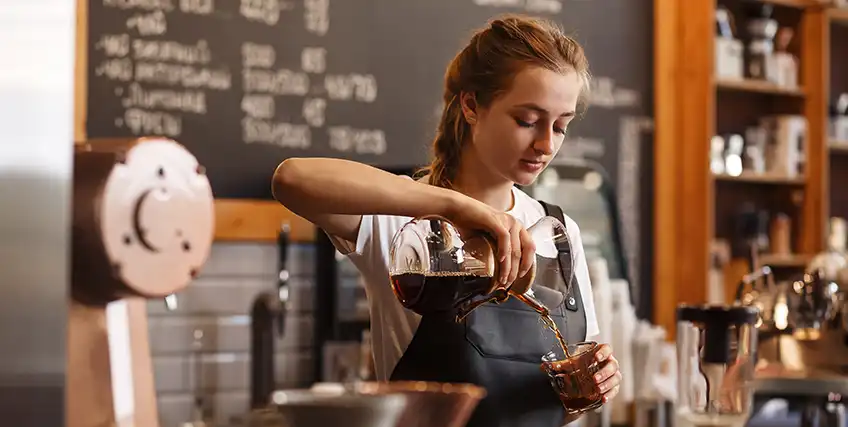How Much Does It Cost to Start a Coffee Shop
March 20, 2025 | Last Updated on: March 24, 2025

Planning to open a coffee shop is not a big deal, but the things that come along with it become a deal to consider. You need to plan many things before opening a coffee shop, especially the coffee shop location.
It might sound exciting to start a coffee shop, but you should also be able to answer questions like "How much will it cost to start a coffee shop?" and "How can you calculate the cost of the coffee shop?"
To cover all these questions, read this article, get tips to make your coffee shop business a hit, and write a story of brewing success.
How to start a coffee shop business
It can be rewarding to start a coffee shop venture, but you should not miss out on the costs before you start to brew.
Expenses like selecting coffee shop location to rent or purchase to getting new equipment for your dream to start a coffee shop are necessary. Below is a structured cost that will help you estimate the cost of starting a coffee shop business.
Location
Coffee shop location is one of the prime things that you need to keep in mind when you want to start a coffee shop. It is like the making or breaking of your coffee shop startup, directly affecting customer attraction. If you can select the right location for your shop, it may become a go-to destination for tourists and locals, giving you brand and identity.
If you want to increase foot traffic in your cafe, you need to select a busy location for your coffee shop startup and check the demographics. This will also help you attract regular customers who can reach your shop easily for treats and drinks. Now the question here is, what will be the best action then? It should always be near a drive-through or area with heavy morning traffic.
You should select your location depending on the type of small business you want to start. Below are some of the examples of demographics:
- Coffeehouse with Drive-Thru: Typically requires up to 1,500 square feet in a retail strip or standalone building.
- Walk-in Coffee Shop: It can operate in as little as 300 square feet in a high-density area but may need up to 1,800 square feet for optimal access to foot and vehicle traffic.
- Drive-Thru Coffee Stand: A compact setup ranging from 100 to 300 square feet is usually sufficient how to run a coffee shop independently.
If you follow the rule, rent or mortgage should take only some percent of your startup business's monthly sales. You should also consider build-out and equipment costs that will add value over time. Moreover, the square feet you have, the more your building costs will be for an independent coffee shop.
Hiring a contractor for this purpose is a good choice, as they will help you understand the cost of heating, electrical, plumbing, and air conditioner systems if you are thinking about how to start a coffee shop business.
Equipment
The equipment you should purchase to start a coffee shop isn't the same as your home coffee machine, even if what you have is top tier. You need to buy items that make the kind of quality coffee people will be willing to pay for, bring efficiency to the operation, and can withstand extreme wear and tear.
This type of equipment is costly, and you will need more of it depending on the size of your operation and the number of customers you expect to serve at peak periods of your new business.
Here are a few pieces of equipment that no coffee shop can go without:
- Water filtration system
- Commercial coffee grinder
- Coffee roaster
- Drip coffee maker
- Some form of refrigeration to keep milk and other things cold.
- Espresso machine
- Blenders for specialized drinks
- Coffee beans
When you add high-quality coffee grinder and espresso machines to run a coffee shop as new business entrepreneurs, equipment costs rise. It's a good idea to buy only the equipment you need to operate your shop on opening day and scale up over time. Investing precious start-up dollars in things you may not use doesn't make sense.
Find staff and vendors
Food and labor expenses are prime costs in the food service industry. Together, they shouldn’t exceed 60 to 65% of total operating expenses. This is a more manageable goal for coffee shops to hit than other food service businesses because they typically serve a more limited number of things.
For coffee shops:
- 60 to 65 percent of prime costs should go to labor, including a barista and servers
- Food and beverage costs should average 28 to 35 percent of total sales
- Regular coffee drinks should have an average margin of 15 to 20 percent
- Specialty coffee drinks should target an average margin of 12 to 18 percent
These are benchmarks.
Marketing of coffee shop
A marketing plan is crucial for attracting customersto start a coffee shop, especially in today’s competitive marketplace. You may be able to handle simple marketing tasks like posting on social media, setting up a Google Business Profile, or managing some Google Ads.
You can also start loyalty programs to make high-quality specialty coffee for your customers with the help of social media.
Still, spending some money on professional branding and marketing strategy support could be a good investment, especially when trying to attract people from the existing coffee shops in the community.
If you decide to go the professional route, you should expect to spend enough money monthly for part-time marketing support and direct marketing strategy expenses.
Get a POS system and financial software
Another relatively high cost to start a coffee shop is transaction technology, typically a point-of-sale system. POS software for a new coffee shop can cost between $50 and $200 per month. The hardware to run the system will likely be a one-time payment of between $1,200 and $4,000.
POS software is expensive for a start-up coffee shop. However, it will pay for itself over time, making inventory and transactions easier to track.
Secure your small business
You'll likely need to purchase insurance and a security system to start a coffee shop. Most landlords and lenders will require these things. Insurance costs will vary depending on what it covers, business size, location, limits, insurer, property value, etc.
Security system prices have fallen in recent years, and a basic one should be available for under $500 plus a minimal monthly monitoring fee.
Get the permits
Finally, before you set a grand opening date to start a coffee shop startup, you'll be required to get permits and licenses to run your business, serve coffee and food, play music, hire employees, and more. The first permits every small business must acquire are a business license and Employer ID Number (EIN). These allow you to operate a legitimate business with employees for a new coffee shop.
A certificate of occupancy and food service license are also required to start a coffee shop and understand how to run a new coffee shop. Suppose you plan to serve alcohol as part of your coffee shop concept, which is becoming popular because it extends small business hours and revenue possibilities. In that case, you'll also need a liquor license.
All these permits carry application costs that vary among the states and municipal authorities that could be involved. Based on your small business size and complexity, location, and types of food and services, keep a budget of hundreds to a few thousand dollars for permits.
Coffee shop business plan
Creating a complete business plan is the first step to start a coffee shop before you think of a opening day. It is often required to secure funding. However, it’s far more critical than that. It’s a way to plan the steps to understand how to start a coffee company.
Once you’ve completed the planning process, you should be able to determine whether opening a coffee shop is a smart move.
A small business plan can help you figure out your startup cost:
- How much money you can expect to earn operating your coffee shop
- What it will take — and how long it will take — to build a solid and dependable customer base
- What types of equipment will you need, and how much will it cost?
- How many people will you need to hire, what positions will you be hiring for, and what is your payroll?
- Marketing plans, including social media, signage, email, digital ads, flyers, and other tactics
- How many locations do you plan to open, size, and whether you plan to rent or own them?
- The products you plan to serve and how you’ll serve them
- Cash flow projections
- How you plan to fund the business: personal funds, loans, or equity
- Business bookkeeping and accounting plans
By the end of the business planning process, you’ll have a strong sense of whether it makes sense for you to do the hard work and open your own coffee shop.
Conclusion
Starting a coffee shop requires thorough planning since it will be a startup, from selecting the right location to budgeting for equipment, staffing, marketing, and permits for entrepreneurs. Understanding costs and financial projections is crucial to ensuring long-term success.
A well-structured business plan can help you determine profitability, secure funding, and create a roadmap for growth for your own coffee shop. While opening a coffee shop is an exciting venture, careful preparation, and strategic decision-making will set you up for success.
If you are ready to put in the effort and make informed choices, you can start a coffee shop that thrives in a competitive market and becomes a beloved community hub.
FAQs about Start a Coffee Shop
What to know before starting a coffee shop?
There are some checklists you need to verify before starting a coffee shop business. You need to create a business plan for your coffee shop, look for a location, select the menu of your shop, order equipment for your coffee shop, and much more.
What are some questions to ask about coffee?
The questions you need to ask for a successful coffee shop are, like do you drink coffee, when you do so, what you feel when you want to have a cup of coffee, are you addicted to the same, and how many people feel espresso is bitter and likewise.
How profitable is a coffee shop?
The average revenue of coffee shops nationally is between 75% and 80% of sales, higher than some restaurant business models. Your coffee shop's revenue is affected by its location, menu, labor costs, and many other factors.
Is it hard to start a coffee shop?
The steps to starting a coffee shop are often straightforward, but opening a coffee shop is not as easy as it seems if you don't do your research and planning. There are potential pitfalls everywhere, and tremendous financial risks can devastate your finances and dream of a successful coffee shop.
What is the failure rate of coffee shops?
If you are thinking of opening a coffee shop, make sure you keep these points in mind. Good management, finding your differentiation, selecting the right location, acquiring coffee-making skills, and having capital are key to avoiding being part of the 26% of coffee shops that fail.




